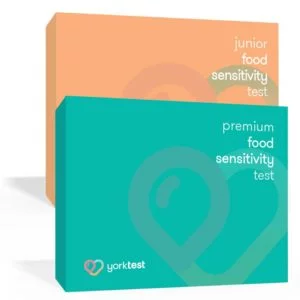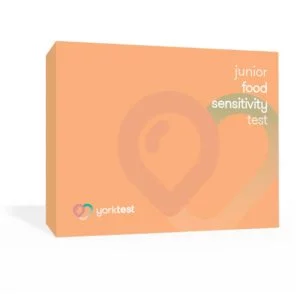- What is a Celery Allergy?
- Is Celery Allergy Common?
- Signs and Symptoms of Celery Allergy
- Celery Intolerance vs Allergy
- The Link Between Celery and Oral Allergy Syndrome
- What Foods to Avoid If Allergic to Celery?
- How to Test for Celery Allergy?
- Skin Prick Testing
- Blood Tests
- Oral Food Challenge (OFC)
- Elimination Diet and Food Diary
- How Do I Manage My Allergy to Celery?
- Emergency Response: Managing Acute Reactions
- Allergen Immunotherapy: A Long-Term Approach
- Learn more about YorkTestâs food sensitivity and allergy testing services
Celery Allergy: Identifying Symptoms, Triggers and Treatments
Celery is a favorite staple in soups, stews, and snacks around the world. But for people who are allergic to celery, consuming it can trigger an allergic reaction that can range from mild discomfort to severe health risks. If you are sensitive or allergic to celery, understanding the nature of celery allergy is vital.
In this blog we look at how you can identify celery allergy symptoms early on and better understand what triggers these responses. We will also look at ways to test for celery allergy as well as ways to manage and mitigate the condition.
What is a Celery Allergy?
A celery allergy is a rapid onset adverse reaction that some people experience when they consume celery or products containing celery derivatives. When someone with a celery allergy eats this vegetable, their immune system releases antibodies called Immunoglobulin E (IgE). These antibodies travel to cells and release chemicals, causing symptoms like itching or swelling. This overreaction can range from mild discomfort to severe reactions known as anaphylaxis, a life-threatening condition requiring immediate medical attention.
As part of the Apiaceae family, celery comes in various forms and names, including stick celery, celeriac, celery root, root celery, celery tuber, and knob celery. It is a popular vegetable that’s grown throughout the world, mainly for the green leaf stalks. In parts of Europe, celery sensitization has been reported in 30% and 40% of individuals who have a food allergy.
One well-known allergen in fresh vegetables like celery is profilin. Another includes substances related to birch and mugwort (often referred to as birch mugwort celery syndrome) in which the immune system mistakes the food for pollen.[1, 2]
Some individuals with a celery allergy may be able to eat cooked celery, as high temperatures can break down the causative proteins. However, celery seed, celery salt, and other spice mixtures containing celery can trigger an allergic reaction and should be best avoided.
Is Celery Allergy Common?
Celery allergy varies widely around the globe but overall, it is relatively uncommon. In parts of Europe, the prevalence of celery allergy has been reported to range between 2.8% and 11.1% based on sensitization, and 5.5% for self-reported celery allergy. A study in Taiwan reported sensitization rates of 1.8%. [3]
Based on data published in 2010 and 2014, sensitivity to celery allergens has been increasing in the general population, from 3.5% to 6.3%.[4] In central Europe, celery allergy is one of the most frequent triggers for food-related allergies, with a Swiss study reporting that 42% of food-allergic adults reacted to celery.[5]
This data suggests regional cuisine can heavily influence allergy prevalence. Americans seem less affected by comparison but awareness regarding this allergen is beneficial, even though data on celery allergy prevalence in the US is inconclusive to date.
Signs and Symptoms of Celery Allergy
An allergic reaction to celery can take on a variety of signs and symptoms, which sometimes might be mistaken for other conditions. Being aware of these reactions can help you recognize an allergic response to celery. The most common celery allergy symptoms include:
- Itching, redness, or mild swelling of the lips, tongue, mouth, throat, and ears
- Stomach pain, nausea, and vomiting
- Skin rash with red raised or unraised bumps
- Hives, itchy skin, and eczema
- Shortness of breath and/or wheezing
- Sneezing and coughing
- Diarrhea and abdominal pain
- Difficulty swallowing
- Severe reactions like anaphylaxis
Extreme symptoms of anaphylaxis can include difficulty breathing, faintness, dizziness, swollen tongue, tight chest, and loss of consciousness. The presence of any combination of these symptoms warrants immediate medical attention and often requires treatment with epinephrine, a medication capable of reversing the effects.
Celery Intolerance vs Allergy
Understanding the difference between celery intolerance and allergy is crucial for effective management. While they may seem similar, they can manifest differently.
An intolerance to celery typically leads to digestive distress, like bloating or gas, with slow-onset symptoms that can manifest up to 72 hours after consuming celery or its product derivatives. This happens because your gut struggles to break down certain compounds in celery. An allergy, however, involves an immediate immune system response that can affect multiple organs and lead to more severe symptoms such as hives or anaphylaxis—a potentially life-threatening condition.
If you have a celery allergy, even a small amount of the food can trigger signs like itching in your mouth right up to serious breathing difficulties or a drop in blood pressure. These reactions are caused by IgE antibodies mistaking harmless proteins found in celery for threats and attacking them.
A person with celery sensitivity might lack specific digestive enzymes that help break it down, which leads to uncomfortable gastrointestinal symptoms post-consumption. On the flip side, allergies are an immediate immune system response where safe substances are misidentified as threats, kicking the body’s defensive mechanisms into gear.
The Link Between Celery and Oral Allergy Syndrome
When it comes to understanding how celery might trigger allergic reactions, the concept of Oral Allergy Syndrome (OAS) is key. Also known as pollen-food syndrome, OAS occurs when someone who is already allergic to certain pollen experiences cross-reactive symptoms after eating fresh fruits or vegetables.
Celery allergy often falls under the umbrella of OAS because its allergenic proteins are structurally similar to those found in certain tree pollen. If you’re sensitive to birch pollen, there’s a chance that consuming celery could provoke an oral reaction because of this similarity which is also known as cross-reactivity.
Birch pollen and foods like apples, carrots, and celery share enough common protein structures that your immune system can mistake them for one another. When this happens, it launches an attack resulting in uncomfortable symptoms localized primarily around the mouth area immediately following consumption.
If you have a history of hay fever or specific tree-pollen allergies during springtime peaks—and then notice tingling or itching sensations around your lips after munching on some crisp stalks—it’s possible you’re experiencing OAS related to celery intake. These signs can manifest within minutes and usually include itching or tingling sensation in the lips, tongue, and throat. Milder cases tend not to progress beyond these localized effects; however, severe instances may lead to systemic responses.
What Foods to Avoid If Allergic to Celery?
If you have a celery allergy, try and avoid raw celery and also processed products that contain celery or its derivatives. Some foods to steer clear from if allergic to celery include:
- Celery stalks and bulbs: Raw or cooked celery stalks and bulbs.
- Celery seeds and derivatives: Celery seeds, celery salt, and celery powder, are often used in spice mixtures, soups, salad dressings, broths, and sauces.
- Processed foods: Various processed foods such as soups, stocks, tomato juice, stews, cured bacon, marmite, salads, and potato chips (crisps) may contain celery or its derivatives.
- Cross-reactive foods: Some individuals with a celery allergy may also experience symptoms when eating foods that cross-react with celery, such as apples, carrots, cherries, peaches, hazelnuts, and peanuts. (See chart)
To make sure you avoid exposure to celery allergens, make a habit of reading food labels carefully on store-bought products. When dining out, be cautious of cross-contamination, particularly in restaurants where a mirepoix base (onion and celery) is used for many sauces.
If you have a severe celery allergy, be vigilant about avoiding these foods and seek alternatives when cooking or dining out. Always consult a healthcare professional for personalized advice and management of a celery allergy.
How to Test for Celery Allergy?
Unlike intolerance, celery allergy is a type of food allergy where the immune system reacts abnormally to proteins found in celery. If you suspect that you have a celery allergy, it’s important to get tested so you can manage your condition effectively. Here are the different types of testing methods used to diagnose a celery allergy.
Skin Prick Testing
The most common method used by allergists for diagnosing food allergies is the skin prick test. During this procedure, small amounts of potential allergens are introduced into your skin using a tiny needle. If you’re allergic to any of these substances-including celery-you’ll experience redness and swelling at the site within 15-20 minutes.
Blood Tests
If a skin prick test isn’t suitable or conclusive enough – perhaps due to certain medications or severe eczema – blood tests may be carried out instead. These measure IgE antibody levels which are produced when your body encounters an allergen like celery. These tests are reliable and easy to conduct, and there are now many at-home test kits available.
Oral Food Challenge (OFC)
An Oral Food Challenge involves consuming gradually increasing quantities of suspected foods under medical supervision until symptoms occur or no reaction is observed after reaching the maximum dosage.
Elimination Diet and Food Diary
In some cases, your healthcare provider may recommend an elimination diet. This involves removing suspected allergens from your diet for some time and then reintroducing them one at a time to see if symptoms return. Keeping a food diary can also help identify patterns between what you eat and when symptoms occur.
Remember, these tests should always be carried out under the supervision of a trained medical professional who can manage any potential allergic reactions.
How Do I Manage My Allergy to Celery?
If you’re grappling with a celery allergy, navigating daily meals and snacks can seem like tiptoeing through a minefield. But armed with the right knowledge and strategies, you can confidently sidestep your allergen without missing out on the joy of eating.
The first line of defense against accidental exposure is mastering food labels. Examine ingredient lists for terms like ‘celery seed,’ ‘celeriac,’ or simply ‘spices’ which may include celery derivatives.
Besides fresh produce sections where cross-contact could occur, also watch out for pre-packaged salads, soups, broths, and seasoning mixes that might contain celery as a hidden ingredient.
Cross-contamination can also occur in areas where food is handled regularly such as in your kitchen or in your favorite restaurant. To keep safe at home:
- Maintain separate cutting boards—one exclusively for non-allergic ingredients—to prevent remnants from causing trouble.
- Clean cooking surfaces thoroughly before use; even tiny traces of an allergen can provoke reactions.
- Educate family members about your allergy so they understand how to help maintain a safe environment for you.
Dining out demands extra caution as well because many chefs use stocks or bases containing hidden amounts of celery as flavor enhancers. Don’t hesitate to ask restaurant staff about their dishes’ contents—and let them know about your allergy upfront—to ensure nothing slips by unnoticed onto your plate.
Living with any food allergy requires attention to detail but does not have to be limiting. With these measures, you’ll be better equipped not only to avoid reactions but also to enjoy dining experiences safely.
Are There Treatments for Celery Allergy?
If you’re allergic to celery, recognizing your available treatment choices can be beneficial to better manage your symptoms. Immediate allergic reactions to celery can range from inconvenient to life-threatening and demand quick action. But it’s not just about managing an attack; there are also ways to handle the allergy long-term.
Emergency Response: Managing Acute Reactions
When it comes to sudden allergic responses, time is of the essence. When experiencing anaphylaxis symptoms such as swelling, hives, or difficulty breathing due to celery consumption, urgent medical attention is required. Epinephrine auto-injectors (EpiPens) are critical in these scenarios as they quickly counteract severe reactions. For less severe cases where discomfort persists but isn’t life-threatening antihistamines might do the trick by easing symptoms such as itching or mild swelling.
A crucial part of being prepared involves always carrying medication and making sure people around you know how to use an EpiPen. Don’t forget that even if epinephrine temporarily fixes things up, hospitalization may still be necessary because biphasic reactions—where symptoms return hours later—are possible.
Allergen Immunotherapy: A Long-Term Approach
Allergen immunotherapy could offer hope for some food allergies over time though its availability for treating specific allergies like those to vegetables is limited and requires more research before becoming widely recommended for celery allergies specifically.
This method works similarly to vaccines—it introduces small amounts of allergens into your system regularly so that your body gets used to it without reacting severely when accidentally exposed again. The goal here isn’t immediate relief but building tolerance gradually which can take years under medical supervision.
Learn more about YorkTest’s food sensitivity and allergy testing services
YorkTest is an accredited laboratory that provides convenient and reliable at-home test kits to identify specific food allergies and sensitivities. While we do not test for celery allergy, our Premium Food Sensitivity Test measures your IgG reactivity to 200 food and drink ingredients, including celery. The test kits include a small, sterilized lancet for a simple finger prick, making it easy to collect a small blood sample in the comfort of your own home. After collecting the blood sample, you mail it to the YorkTest laboratory where it’s analyzed for food-specific reactions. Learn more about YorkTest’s range of test kit products.
Scientific References:
- Wüthrich B, Hofer T. Nahrungsmittelallergie: das “Sellerie-Beifuss-Gewürz-Syndrom”. Assoziation mit einer Mangofrucht-Allergie? [Food allergy: the celery-mugwort-spice syndrome. Association with mango allergy?]. Dtsch Med Wochenschr. 1984 Jun 22;109(25):981-6. German. doi: 10.1055/s-2008-1069310. PMID: 6734454.
- Pauli G, Bessot JC, Braun PA, Dietemann-Molard A, Kopferschmitt-Kubler MC, Thierry R. Celery allergy: clinical and biological study of 20 cases. Ann Allergy. 1988 Mar;60(3):243-6. PMID: 3258136.
- Moonesinghe H, Kilburn S, Mackenzie H, Venter C, Lee K, Dean T. The prevalence of “novel†food allergens worldwide: a systematic review. Clin Transl Allergy. 2015 Mar 30;5(Suppl 3):P9. doi: 10.1186/2045-7022-5-S3-P9. PMCID: PMC4412522.
- Matricardi PM, Kleine-Tebbe J, Hoffmann HJ, Valenta R, Hilger C, Hofmaier S, et al. EAACI Molecular Allergology User’s Guide. Pediatr Allergy Immunol. 2016;27 Suppl 23:1-250.
- Dubiela P, Humeniuk P, Bublin M, Metz-Favre C, Viel S, Bienvenu F, Hafner C, Pauli G, Hoffmann-Sommergruber K. Two patients with allergy to celery – Possible role of carbohydrate determinants and difference between seeds and tuber allergenicity. World Allergy Organ J. 2022 Nov 7;15(11):100708. doi: 10.1016/j.waojou.2022.100708. PMID: 36440466; PMCID: PMC9649391.











